Moulding Surname Ancestry ResultsOur indexes 1000-1999 include entries for the spelling 'moulding'. In the period you have requested, we have the following 78 records (displaying 61 to 70): Single Surname Subscription | | | Buying all 78 results of this search individually would cost £448.00. But you can have free access to all 78 records for a year, to view, to save and print, for £100. Save £348.00. More... |
These sample scans are from the original record. You will get scans of the full pages or articles where the surname you searched for has been found. Your web browser may prevent the sample windows from opening; in this case please change your browser settings to allow pop-up windows from this site. Anglican clergy
(1930)
Crockford's Clerical Directory listed all Anglican clergy in the British Isles, India, the colonies, Europe, Asia and South America. The 59th annual issue, for 1930, is based on returns from all the individuals listed. The details given are: name (surname first, in capitals) in bold, prefixed by an asterisk in the case of university electors, and by a dagger whether the return had not been made, or it had been imperfectly filled up; name of theological college and/or university, and degrees, with years; a bold d followed by year and diocese signifies date of ordination as deacon and by which bishop; then a bold p, similarly for ordination as priest; posts (C: curate; I: incumbent; V; vicar; R: rector) with parishes and years; address; telephone number; and lists of books &c. where appropriate. In the case of the man then holding an English, Irish, Scottish or Welsh benefice, additional details are given - a bold P signifies the patron of the advowson; then the income, with items such as Q. A. B. (Queen Anne's Bounty), Eccles(iastical) Comm(issioners), Fees, e. o. (Easter Offerings), Pew Rents, T(ithe) R(ent) C(harge), Gl(ebe), &c.MOULDING. Cost: £4.00.  | Sample scan, click to enlarge

| Officers of the British Army and of the Indian Army
(1934)
The Half-Yearly Army List, issued By Authority, 30 June 1934, lists all officers in active service at that date, and this list was evidence of the status and rank of the officers contained in it. The entries are set out as a gradation list, by rank, from field-marshals to lieutenants, and within each rank in order of seniority at that rank. Each officer's name (surname first, in capitals, then christian name and present rank (with date of achieving that rank) and regiment &c. are given, for convenience, in bold type, with any national decorations in italics after the name. Each entry also gives date of birth, number of days service in the ranks, dates of service in each rank of officer, particular offices and postings (with dates) and, where appropriate, a summary of war service, and medals. For all but the oldest of the officers then serving, the war service details are for the Great War (1914-1921), and campaigns in Iraq, Waziristan, and the North West Frontier of India. War services are not given in this edition for Indian Army officers, except in that their entries are preceded by a crossed swords symbol where they have seen war service in a theatre of war overseas. After the gradation list of officers, there is a section for the Royal Malta Artillery; and then (pages 1152 to 1185) warrant officers - staff or garrison serjeant-majors, educational serjeant-majors, serjeant-major (physical training and educational) instructors, regimental serjeant-majors (and corporal-majors, farrier-serjeant majors, master gunners, assistant instructors in gunnery, experimental serjeant-majors, artillery clerks, farrier-serjeant-majors, artificer serjeant-majors, clerks of works, mechanist, superintending clerks, draughtsmen, 1st class staff serjeant-majors, transport, supply, conductors, sub-conductors, armourers, armament artificers, headmasters, schoolmasters, marine gunners, and bandmasters. The section for the Royal Army Chaplains' Department lists all chaplains (1st to 3rd class); and that for Queen Alexandra's Imperial Military Nursing Service has all matrons, sisters and staff nurses. The lists of nurses do not give date of birth: all are unmarried. The book concludes with the Yeomen of the Guard, the Honourable Company of Gentlemen-at-Arms, and the King's Body Guard for Scotland, in each case giving name (surname and initials, not christian names), honours, name of late regiment, and date of appointment.
MOULDING. Cost: £4.00.  | Sample scan, click to enlarge

| Congregationalists
(1935)
Who's Who in Congregationalism gives biographical notices of accredited ministers and evangelists, lay pastors and lay officials of the Congregational church in Britain and Ireland. The notices also include the names of wives, with maiden names, and these too are included in the index here.MOULDING. Cost: £6.00.  | Sample scan, click to enlarge
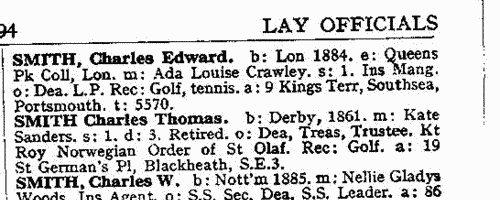
| Pupils at Kesteven and Grantham Girls' School
(1938)
Issues 25,649 to 25,676 of the Nottingham Guardian, the regional daily newspaper, were published Monday to Saturday, in August 1938. Apart from general features, national and international news, the paper - with offices in Nottingham, Derby, Grantham, Lincoln, Loughborough and Mansfield - covered local events throughout the East Midlands. The issue for 30 August includes this pass list for the School Certificate in the Oxford local examinations.MOULDING. Cost: £6.00.  | Sample scan, click to enlarge
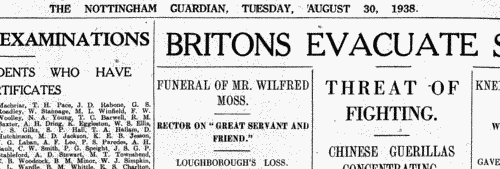
| Aviators' Certificates
(1939)
Lists of certificates granted by the Royal Aero Club of the United Kingdom to newly-qualified aviators of powered aircraft: giving certificate number, full name, and name of his or her aero club. Certificate numbers 16744 to 20093, issued from December 1938 to September 1939.MOULDING. Cost: £6.00.  | Sample scan, click to enlarge

| London Telephone Subscribers
(1939)
The London telephone directory lists subscribers alphabetically by surname and then by christian name or initials, with their postal address and telephone number. This is the L to Z directory issued in May 1939, but also contains some names from earlier in the alphabet, for instance in the separate section for midwives. The London telephone districts comprised not only the city centre, but also the very extensive suburbs in the Home Counties (Essex, Kent, Surrey and Middlesex).MOULDING. Cost: £4.00.  | Sample scan, click to enlarge

| Boys entering Sherborne School
(1943)
The grammar school at Sherborne in Dorset, which doubtless existed from the creation of the diocese of Sherborne in 705, was refounded by king Edward VI in 1550. At the quatercentenary in 1950, a fourth edition of the Sherborne Register was published, listing boys entering the school during those four centuries. In truth, the materials for this register survive but fitfully before 1823; for some years, no names are known; sometimes all that is known is a surname. But from 1823 onwards the lists and the details get steadily more comprehensive. By the 20th century the boys are listed alphabetically by surname under term of entrance. Surname is given in bold, then christian names, name of father (surname and initials) and address; year of birth; house (a, School House; b, Abbey House; c, The Green; d, Harper House (formerly The Retreat); f, Abbeylands; g, Lyon House; h, Westcott House); whether represented the school at cricket (xi), football (xv), shooting (viii), &c.; year of leaving; summary of degrees, career &c.; and (in italics), address as of 1950. Names in the early lists marked with an asterisk are found inscribed on the oak panelling or on the stone walls of the former schoolroom. (F) in the lists indicates a foundationer, receiving free education: after 1827, when this privilege was restricted to boys from Sherborne and neighbourhood, nearly all foundationers were day-boys.MOULDING. Cost: £4.00.  | Sample scan, click to enlarge
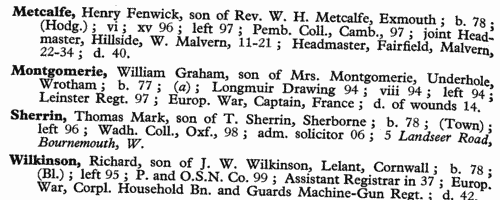
| Graduates of the Institution of Mechanical Engineers (G. I. Mech. E.)
(1947)
The Institution of Mechanical Engineers, founded in 1847, was incorporated by royal charter in 1930. The list of members of 1 March 1947 gives the names (surname first) and addresses of the seven classes of member - Honorary Members (Hon. M. I. Mech. E.); Members (M. I. Mech. E.); Associate Members (A. M. I. Mech. E.); Companions (C. I. Mech. E.); Associates (A. I. Mech. E.); Graduates (G. I. Mech. E.); and Students (S. I. Mech. E.). The year of attaining qualification is given in the left-hand margin; in the higher grades the years of achieving the lower grades are also given, bracketed together. The crossed swords symbol indicates naval or military service during the Great War of 1914-1918; an italic b shows a member of the Benevolent Fund. (p) after a Graduate's or a Student's name indicates one who had passed the whole of the A. M. Examination or its recognized equivalent.MOULDING. Cost: £4.00.  | Sample scan, click to enlarge
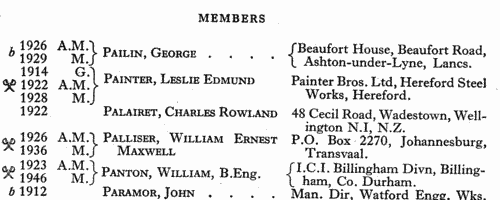
| Chartered Electrical Engineers (M. I. E. E. and A. M. I. E. E.)
(1951)
The Institution of Electrical Engineers was founded in 1871 under the name of The Society of Telegraph Engineers, and incorporated by royal charter in 1921. This list of members, corrected to 2 July 1951, gives the names and addresses of the Members (M. I. E. E.) and Associate Members (A. M. I. E. E.), all of whom were entitled to describe themselves as Chartered Electrical Engineers. The names are given in bold, surname first; before each name is the year of attaining the grade of Associate Member (AM) or Member (M); and, before the address, the year of reaching each lower grade is also given, e. g. (G. 1931), G standing for Graduate, S for Student. Where the engineer was also a member of one of the institution's specialized sections, this abbreviation is given, in bold: M, Measurements Section; R, Radio Section; S, Supply Section; U, Utilization Section.MOULDING. Cost: £4.00.  | Sample scan, click to enlarge

| Electrical Engineers
(1952)
The Institution of Electrical Engineers was founded in 1871, and incorporated by royal charter in 1921. There were seven grades of member (honorary member, member, associate member, companion, associate, graduate, and student); this is the list of the 19,699 members of the latter three grades as of 1 July 1952. Most of the members were from Britain, but there were Oversea Branches for Calcutta, Ceylon and Ireland, and Oversea Committees in Australia, India, Malaya and Singapore, New Zealand and South Africa. The associates (A), graduates (G) and students (S) are listed together in a single alphabetical list by surname and christian name(s), with year of entering the grade. Some of the members also belonged to specialized sections of the institution, and these are indicated at the right by the letters M (measurements), R (radio), S (supply) and U (utilization).MOULDING. Cost: £4.00.  | Sample scan, click to enlarge
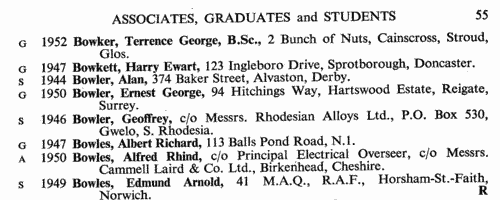
|
Research your ancestry, family history, genealogy and one-name study by direct access to original records and archives indexed by surname.
|












